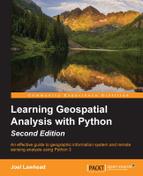In this book, we touched on all the important aspects of geospatial analysis and used a variety of different techniques in Python to analyze different types of geospatial data. In this final chapter, we will draw on nearly all of the topics that we have covered to produce one real-world product that has become very popular: a GPS route analysis report.
These reports are common to dozens of mobile app services, GPS watches, in-car navigation systems, and other GPS-based tools. A GPS typically records location, time, and elevation. From these values, we can derive a vast amount of ancillary information about what happened along the route on which that data was recorded. Fitness apps including RunKeeper.com, MapMyRun.com, Strava.com, and Nike Plus all use similar reports to present GPS-tracked exercise data from running, hiking, biking, or walking.
We will create one of these reports using Python. This program is nearly 500 lines of code, our longest yet, so we will step through it in pieces. We will combine the following techniques in this chapter:
- Accessing online data services
- Combining vector and raster data
- Parsing datasets and data feeds
- Processing raster data
- Producing graphics and reports
As we step through this program, all of the techniques used will be familiar but we will be using them in new ways.
A typical GPS report has common elements including a route map, elevation profile, and speed profile. The following screenshot is a report from a typical route logged through RunKeeper.com:

Our report will be similar, but we'll add a twist. We'll include the route map and elevation profile like this service, but we'll also add the weather conditions that occurred on this route when it was recorded.
